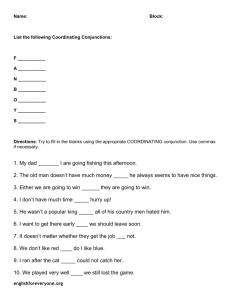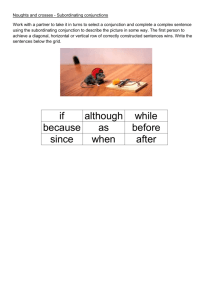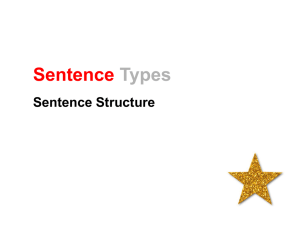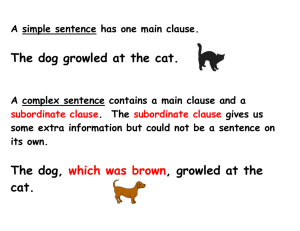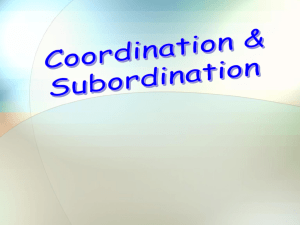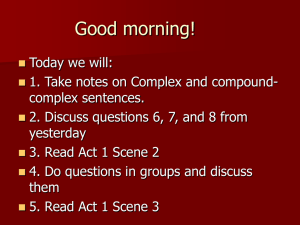Academic Writing and Subordination
advertisement
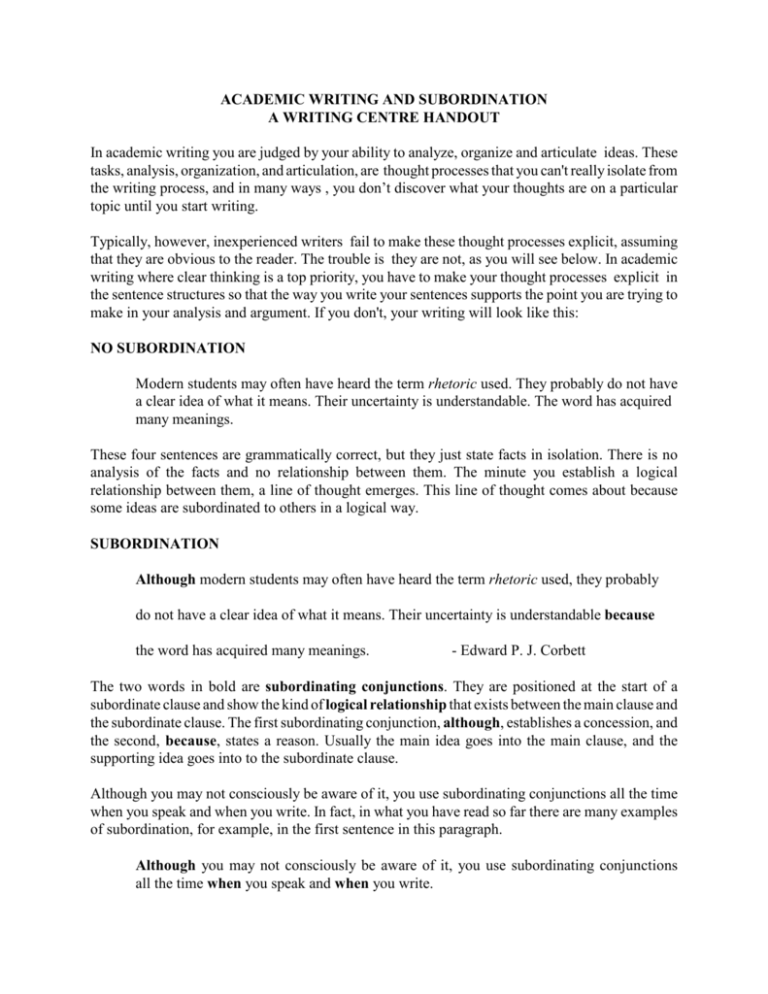
ACADEMIC WRITING AND SUBORDINATION A WRITING CENTRE HANDOUT In academic writing you are judged by your ability to analyze, organize and articulate ideas. These tasks, analysis, organization, and articulation, are thought processes that you can't really isolate from the writing process, and in many ways , you don’t discover what your thoughts are on a particular topic until you start writing. Typically, however, inexperienced writers fail to make these thought processes explicit, assuming that they are obvious to the reader. The trouble is they are not, as you will see below. In academic writing where clear thinking is a top priority, you have to make your thought processes explicit in the sentence structures so that the way you write your sentences supports the point you are trying to make in your analysis and argument. If you don't, your writing will look like this: NO SUBORDINATION Modern students may often have heard the term rhetoric used. They probably do not have a clear idea of what it means. Their uncertainty is understandable. The word has acquired many meanings. These four sentences are grammatically correct, but they just state facts in isolation. There is no analysis of the facts and no relationship between them. The minute you establish a logical relationship between them, a line of thought emerges. This line of thought comes about because some ideas are subordinated to others in a logical way. SUBORDINATION Although modern students may often have heard the term rhetoric used, they probably do not have a clear idea of what it means. Their uncertainty is understandable because the word has acquired many meanings. - Edward P. J. Corbett The two words in bold are subordinating conjunctions. They are positioned at the start of a subordinate clause and show the kind of logical relationship that exists between the main clause and the subordinate clause. The first subordinating conjunction, although, establishes a concession, and the second, because, states a reason. Usually the main idea goes into the main clause, and the supporting idea goes into to the subordinate clause. Although you may not consciously be aware of it, you use subordinating conjunctions all the time when you speak and when you write. In fact, in what you have read so far there are many examples of subordination, for example, in the first sentence in this paragraph. Although you may not consciously be aware of it, you use subordinating conjunctions all the time when you speak and when you write. 2 DEFINITIONS A SUBORDINATE or DEPENDENT CLAUSE is introduced by a subordinating conjunction and always has a subject and a verb/predicate: when you write ( subordinating conjunction. + subject + verb and what follows the verb). A MAIN CLAUSE has a subject and a verb/predicate and has no conjunction that subordinates it to another clause. It is independent and can stand on its own whereas a subordinate clause is always connected to a main clause. When you become conscious of the need for subordination and learn to use it correctly, you give yourself an important tool to improve your writing. To help you, I have started putting all subordinating conjunctions in bold. The first step in the process of learning to use subordination is to identify the subordinating conjunctions and their meaning. Subordinating conjunctions signal many different logical relationships. LOGICAL RELATIONSHIP TIME after as as long as as soon as once before since until when whenever while CONCESSION and CONTRAST although even though though whereas REASON or CAUSE because since as CONDITION as if as though if even if provided that unless PURPOSE or RESULT in order that lest so that CHOICE PLACE rather than where whether wherever RELATIVE PRONOUNS (not exactly subordinating conjunctions but pronouns that connect the subordinate clause to a specific noun in the main clause.) who, whom, whose which that (used about people) (used about things) (used about both if the clause is essential to the main clause) 3 EXAMPLES OF SUBORDINATION. The subordinate clauses are in bold: The noise that kept bothering me came from the water softener. A cynic is a man who knows the price of everything and the value of nothing. -Oscar Wilde If you work and have small children, you must juggle conflicting responsibilities. The store closed when the owner died. Sarah was happy because she had just passed her exam. Although he had studied hard, he did not pass the exam. I worked as a waitress for a year so that I could earn money for university. COORDINATION The second step in the process of learning to use subordination is to recognize its opposite: COORDINATION. If subordination means that one clause is reduced to secondary importance compared to another, coordination means that two clauses, put side by side, are of equal importance and weight. You can join main clauses in two ways: Use a comma and one of the seven coordinating conjunctions, here shown in italics: and, but, for, or, nor, so, yet (A.B.Fonsy, for short) The economists considered budget cuts, and the politicians thought of votes. Or link the two main clauses with a semicolon: The economists considered budget cuts; the politicians thought of votes. A semicolon signals to the reader that there is a connection between the two clauses, but it is up to the reader to see it. No conjunction spells it out in detail. In fact, a semicolon makes people think, so it is both a suggestive and elegant way of adding depth and detail to your writing. 4 Another variation on the same idea is to use a conjunctive adverb between the two clauses. The economists considered budget cuts; however, the politicians thought of votes. You will notice that the conjunctive adverb is followed by a comma in exactly the same way as an adverb at the beginning of a sentence is followed by a comma. Initially, we planned cuts to the budget. Some of the most common conjunctive adverbs are: however, moreover, nevertheless, similarly, finally, then, therefore, thus, consequently SENTENCE FRAGMENTS The third step in the process of learning to use subordination is to recognize the kind of writing error that can crop up when you use it: SENTENCE FRAGMENTS. A sentence fragment is an incomplete sentence, punctuated as if it were complete. Sometimes a sentence fragment occurs when either the subject, verb, or both are missing from the sentence, but most often it occurs when a subordinate clause is punctuated as if it were a main clause. NO: I use the spell check function on my computer all the time. Because I am a bad speller. A subordinate or dependent clause punctuated as a main clause is considered a fragment because to be complete, it "depends" on the independent clause and must therefore not be separated from it. YES: I use the spell check function on my computer all the time because I am a bad speller. YES: Because I am a bad speller, I use the spell check function on my computer all the time. The best way to avoid writing fragments is to memorize the seven coordinating conjunctions listed above. If a conjunction is not one of the seven coordinating ones, you will know that it must be a subordinating conjunction; this will remind you not to punctuate the dependent clause as if it were an independent one. © EmmyMisser, Manager, Writing Centre, Wilfrid Laurier University, www.wlu.ca/writing
